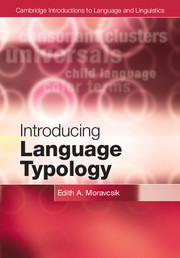Book contents
- Frontmatter
- Contents
- List of figures
- Preface
- List of copyright permissions
- List of abbreviations
- Chapter 1 What is language typology?
- Chapter 2 The worlds of words
- Chapter 3 Assembling words
- Chapter 4 Dissembling words
- Chapter 5 The sounds of languages
- Chapter 6 Language in flux
- Chapter 7 Explaining crosslinguistic preferences
- List of languages mentioned
- Glossary
- References
- Subject index
- Language index
- Author index
Chapter 3 - Assembling words
Syntactic typology
Published online by Cambridge University Press: 05 February 2013
- Frontmatter
- Contents
- List of figures
- Preface
- List of copyright permissions
- List of abbreviations
- Chapter 1 What is language typology?
- Chapter 2 The worlds of words
- Chapter 3 Assembling words
- Chapter 4 Dissembling words
- Chapter 5 The sounds of languages
- Chapter 6 Language in flux
- Chapter 7 Explaining crosslinguistic preferences
- List of languages mentioned
- Glossary
- References
- Subject index
- Language index
- Author index
Summary
Chapter outline
Some of the syntactic differences and similarities among languages will be surveyed and a sample of crosslinguistic generalizations will be documented. After a brief introduction, Section 3.2 illustrates crosslinguistic similarities and differences in the choice of words and word forms using the examples of resumptive pronouns as they occur in relative clauses, and of classifiers, agreement, and government. Section 3.3 illustrates frequencies of order patterns and statistical correlations between the orders of major sentence constituents, such as subject, object, and verb, and other phrases. On the example of the concept subject, Section 3.4 raises the issue of whether grammatical categories are crosslinguistically definable.
Introduction
Suppose you want to say something in a language unknown to you. You have a dictionary; but how do you put the words together into a sentence? A reasonable approach is to pick the words that jointly express the intended meaning and put them into some logical order, such as placing the more important words before the less important ones. This method might indeed work if the goal is just to convey the approximate meaning; but the resulting sentence is not likely to be a well-formed structure. This is for three reasons.
(a) Languages differ in the choice of words that are used to express a given meaning.
(b) Languages differ in the choice of words forms that are used to express a given meaning.
(c) Languages differ in the order of words that are used to express a given meaning.
The choice and ordering of words and word forms is called syntax; crosslinguistic differences and similarities in syntactic structures is the topic of this chapter.
- Type
- Chapter
- Information
- Introducing Language Typology , pp. 65 - 108Publisher: Cambridge University PressPrint publication year: 2012

